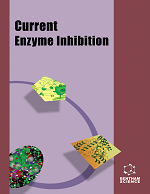- Home
- A-Z Publications
- Current Enzyme Inhibition
- Previous Issues
- Volume 3, Issue 2, 2007
Current Enzyme Inhibition - Volume 3, Issue 2, 2007
Volume 3, Issue 2, 2007
-
-
Nitric Oxide Synthase Inhibition and Renal Injury
More LessAuthors: Joel D. Starnes and Sharma S. PrabhakarThe past decade has witnessed an explosive growth of literature related to the role of nitric oxide (NO) in renal physiology and pathophysiology. Alterations of renal NO generation have been incriminated in various renal disorders. Excessive production of NO by NOS II in infiltrating immune cells and mesangial cells was described in acute glomerulonephritides and inhibition of NOS II resulted in protection from such renal inju Read More
-
-
-
Enzyme Inhibition by Peroxynitrite-Mediated Tyrosine Nitration and Thiol Oxidation
More LessAuthors: Andreas Daiber and Markus BachschmidNitric oxide (.NO, EDRF), a potent vasodilator is formed from arginine by NO synthases. Under physiological conditions endothelial NO synthase (NOS3) yields low steady-state .NO levels dilating the smooth muscle of the vasculature via activation of the soluble guanylyl cyclase. Superoxide (O2.-), a toxic reactive oxygen species that easily reacts with metal-sulfur-clusters and causes oxidative damage via Fenton chemistry, is Read More
-
-
-
Lipoxygenases - A Challenging Problem in Enzyme Inhibition and Drug Development
More LessLipoxygenases (LOXs), cytochromes P450 (CYPs) and cyclooxygenases (COXs) catalyze peroxidation of unsaturated fatty acids. In humans they convert arachidonic acid into a variety of eicosanoids, which play a role in all inflammatory responses, cardiovascular and kidney diseases, Alzheimer's, cancer and other ailments. Blocking one pathway can prompt the body to switch to the available alternatives. In contrast to Read More
-
-
-
Phosphatidylcholine Biosynthesis as a Potential Target for Inhibition of Metabolism in Parasitic Nematodes
More LessParasitic nematodes are major causes of human, animal, and plant diseases worldwide. Although a number of therapeutics are available as treatments, reported resistance to certain anthelmintics, severe side-effects, or limited efficacy resulting from differences in the life cycles of target organisms underscore the need for the continued development of nematicidal compounds. Identifying biochemical targets that differ be Read More
-
-
-
Modulation of Mitochondrial Protein Kinase C Isozymes: A New Therapeutic Frontier?
More LessAuthors: Tiffany Nguyen, Mourad Ogbi, Dehuang Guo and John A. JohnsonAlterations in protein kinase C (PKC) isozymes and mitochondrial functions such as oxidative phosphorylation (OXPHOS) and apoptosis have each been implicated in human diseases. However, relatively little is currently understood regarding the physiologic roles of individual PKC isozymes or their substrates for phosphorylation in mitochondria. Recent advances in mitochondrial localization of PKC isozymes and methods of PKC Read More
-
-
-
Recent Advances and Developments in the Inhibitors of DNA Topoisomerases
More LessAuthors: Wai M. Liu and Robert H. te PoeleRecent years have seen the development of the latest generation of inhibitors of the topoisomerase enzymes. New discoveries and improvements to methodologies underpinning drug design and discovery have caused a renewed interest in the ubiquitously expressed DNA topoisomerases. Virtually every aspect of nucleic acid physiology is influenced by the topological state of DNA, which is managed predominantly by these Read More
-
Volumes & issues
-
Volume 20 (2024)
-
Volume 19 (2023)
-
Volume 18 (2022)
-
Volume 17 (2021)
-
Volume 16 (2020)
-
Volume 15 (2019)
-
Volume 14 (2018)
-
Volume 13 (2017)
-
Volume 12 (2016)
-
Volume 11 (2015)
-
Volume 10 (2014)
-
Volume 9 (2013)
-
Volume 8 (2012)
-
Volume 7 (2011)
-
Volume 6 (2010)
-
Volume 5 (2009)
-
Volume 4 (2008)
-
Volume 3 (2007)
-
Volume 2 (2006)
-
Volume 1 (2005)
Most Read This Month
Article
content/journals/cei
Journal
10
5
false
en


